The Origins and Popularity of Oolong Tea and Coffee
Tea and coffee are two of the most widely consumed beverages in the world, enjoyed by people of all ages and cultures. Oolong tea and coffee, in particular, have fascinating origins and histories that have contributed to their popularity today.
The Origins of Oolong Tea
Oolong tea has its roots in China during the Ming Dynasty (1368-1644). Legend has it that a tea farmer was distracted by a deer while picking tea leaves, causing them to wilt and oxidize before he could process them as green tea. The resulting tea had a unique flavor and aroma, which led to its popularity.
Oolong tea became a favorite among the Chinese elite, and was eventually exported to other countries such as Taiwan and Japan. Today, oolong tea is enjoyed around the world, with regional variations and preparation methods.
The Origins of Coffee
Coffee, on the other hand, originated in Ethiopia, where it was consumed as a medicinal drink as early as the 9th century. It was introduced to the Arab world in the 15th century, and quickly became popular for its stimulating effects.
When coffee was brought to Europe in the 16th century, it was initially viewed with suspicion by religious authorities who saw it as a “Muslim drink.” However, it soon became popular among the upper classes as a social beverage. Coffee was introduced to the Americas in the 17th century, and became a major commodity in colonial trade.
Regional Variations and Preparation Methods
Today, both oolong tea and coffee are enjoyed worldwide, with different regional variations and preparation methods.
Oolong Tea
- Chinese oolong teas are known for their floral and fruity flavors, and are often enjoyed in small cups.
- Taiwanese oolong teas are more heavily oxidized, resulting in a darker color and stronger flavor.
- Japanese oolong teas are often blended with green tea, resulting in a lighter color and more delicate flavor.
Coffee
- Italian espresso is a strong, concentrated coffee served in small cups.
- French press coffee is made by steeping coarse coffee grounds in hot water, resulting in a rich, full-bodied flavor.
- American drip coffee is made by pouring hot water over coffee grounds in a filter, resulting in a milder flavor and lighter color.
Whether you prefer the delicate flavors of oolong tea or the bold flavors of coffee, both beverages have rich histories and unique regional variations that make them beloved by people around the world.
So the next time you enjoy a cup of oolong tea or coffee, take a moment to appreciate the centuries of tradition and innovation that have gone into creating these beloved beverages.
The Battle of Antioxidants: Oolong Tea vs Coffee
For many of us, starting our day with a cup of coffee is a must. But have you ever considered swapping it for a cup of oolong tea? Oolong tea is known for its high antioxidant content, specifically polyphenols and catechins, which protect cells from damage caused by free radicals. Antioxidants are also beneficial for reducing inflammation in the body, which can help prevent chronic diseases like cancer and heart disease.
Antioxidants in Coffee
But wait, coffee also contains antioxidants, particularly chlorogenic acid, which has been linked to lower risk of type 2 diabetes, heart disease, and certain cancers. However, the levels of antioxidants in coffee can vary depending on the type of bean, roast, and brewing method.
Caffeine Content
In terms of caffeine content, oolong tea typically contains less caffeine than coffee, with an average of 30-50 mg per cup compared to coffee’s 95 mg per cup. However, the exact amount of caffeine can vary depending on the type and preparation of the tea. While caffeine can have some health benefits, such as improved focus and energy, it can also cause negative effects like anxiety, insomnia, and increased heart rate. As such, individuals may prefer oolong tea over coffee if they are sensitive to caffeine or trying to reduce their caffeine intake.

Nutrient Content
But the battle of antioxidants and caffeine is not the only factor to consider. Oolong tea is also a good source of other nutrients like manganese, potassium, and magnesium, which are important for maintaining healthy bones, muscles, and nerves. Coffee also contains some nutrients like niacin, magnesium, and potassium, but these are typically in small amounts.
The Bottom Line
Overall, both oolong tea and coffee contain antioxidants and other nutrients that can provide health benefits. However, the levels of these compounds can vary depending on the specific type and preparation of the beverage. Individuals may choose one over the other based on personal taste preferences and sensitivity to caffeine.
So, the next time you are faced with the decision of whether to grab a cup of coffee or oolong tea, weigh the benefits and decide which one suits your needs best. And who knows, you may even want to switch it up every once in a while for a change of pace and a boost of antioxidants!
Oolong Tea vs. Coffee: A Taste and Aroma Comparison
When it comes to choosing a beverage to start your day or to enjoy during afternoon tea, there are many options to consider. Two popular choices are oolong tea and coffee. While they may seem like vastly different drinks, they actually share a few similarities. Let’s take a closer look at the taste and aroma profiles of oolong tea and coffee.
Oolong Tea
Oolong tea is a delicate and nuanced tea that has a unique flavor profile. It contains floral notes, hints of fruit, and a slightly nutty aftertaste. This combination of flavors creates a sweet and earthy taste that is both complex and satisfying. The aroma of oolong tea is also floral, with notes of honey and a hint of woodiness.
Coffee
Coffee, on the other hand, is a strong and bold beverage that can be bitter or sweet depending on the roast and brewing method. It often has notes of chocolate, caramel, or nuts, and its aroma is rich and complex. The scent of roasted beans is prominent, with an earthy undertone and sometimes a hint of fruitiness.
Unique Taste and Aroma
While oolong tea and coffee may share a few similarities in their aroma and taste, they are distinctly different beverages. Oolong tea is delicate and floral, while coffee is bold and rich. These differences make them both unique and appealing to different palates.
Ultimately, the choice between oolong tea and coffee comes down to personal preference. Both beverages have their own loyal fans who enjoy the taste and aroma profiles that they offer. So, whether you prefer a sweet and earthy oolong tea or a bold and rich cup of coffee, take the time to savor the flavors and aromas that each beverage has to offer.
Brewing the Perfect Cup: Tips and Techniques for Oolong Tea and Coffee Lovers
There’s nothing quite like a perfectly brewed cup of tea or coffee to start your day off right. Whether you’re a fan of the rich, earthy flavors of oolong tea or the bold, energizing taste of coffee, there are plenty of techniques and tips you can use to ensure that every cup you make is truly exceptional. Here are some tips and tricks for brewing the perfect cup of oolong tea or coffee:
Brewing Oolong Tea
If you’re a fan of oolong tea, there are a few key steps you can follow to ensure that your tea is brewed to perfection:
- Use fresh water that has not been boiled before (to prevent oxygen loss)
- Heat the water to around 190-200F (87-93C)
- Use 1-2 teaspoons of loose leaf oolong tea per cup (depending on desired strength)
- Steep for 3-5 minutes (depending on desired strength)
- Re-steep the leaves multiple times (each time adding 30 seconds to the steep time)
- Serve the tea hot or cold, plain or with milk/honey/etc.
By following these steps, you can ensure that your oolong tea is brewed to perfection every time. And don’t be afraid to experiment with different brewing methods and steep times to find the flavor that’s perfect for you!
Brewing Coffee
Coffee lovers know that there’s nothing quite like a perfectly brewed cup of joe to start your day off right. Here are some tips for brewing the perfect cup of coffee:
- Use fresh, cold water
- Heat the water to around 195-205F (90-96C)
- Use 1-2 tablespoons of coarsely ground coffee per 6 ounces of water
- Pour water over the coffee grounds and let it brew for 4-5 minutes (depending on desired strength)
- Press the plunger down (if using a French press) or use a filter to separate the grounds from the coffee
- Serve the coffee hot or cold, plain or with milk/sugar/etc.
With these tips, you can be sure that your coffee is brewed to perfection every time. And don’t be afraid to experiment with different brewing methods and types of coffee to find the flavor that’s perfect for you!
Tips for Making the Perfect Cup
Whether you’re a fan of oolong tea or coffee, there are some general tips and techniques you can use to ensure that every cup you make is truly exceptional:
- Use high-quality ingredients (fresh tea leaves/coffee beans, good water)
- Follow the recommended brewing times and temperatures
- Experiment with different brewing methods to find your preferred taste
- Use a timer to avoid over-steeping or under-steeping
- Preheat your cup/mug to keep the temperature consistent
- Use a scale to measure the tea leaves/coffee grounds for accuracy
- Store your tea/coffee properly to maintain freshness (in an airtight container, away from light and moisture)
By following these tips and techniques, you can be sure that every cup of tea or coffee you make is truly exceptional. So the next time you’re brewing your favorite beverage, be sure to keep these tips in mind and enjoy the perfect cup!


Leave a Reply